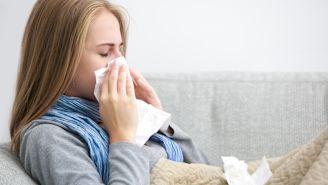Beaches, trails and waterfalls are hallmarks of the sunny outdoor lifestyle Hawaii residents enjoy—but lurking beneath the surface of our sparkling waters is a possibly life-threatening illness: flesh-eating disease.
Anecdotally, there do seem to be more news reports of necrotizing fasciitis—a serious, quickly spreading and potentially deadly bacterial infection sometimes dubbed “flesh-eating bacteria”—in warmer weather. This is possibly because people expose more skin in the heat.
But before you panic, realize that your chances of developing it are very low.
Nationwide, the incidence ranges from between 0.3 to 15 cases per 100,000 people—or between 0.0003 and 0.015 percent. And according to an estimate from the National Organization for Rare Disorders, necrotizing fasciitis is so uncommon that doctors on average see only two cases during their careers.
Still, the Centers for Disease Control and Prevention (CDC) says that 600 to 1,200 cases are reported to it each year. Exact numbers for cases in Hawaii are hard to pinpoint, though, as the state does not keep official records for the number of necrotizing fasciitis infections that occur locally, according to Sarah Park, MD, head of the Disease Outbreak Control Division at the State of Hawaii Department of Health.
Here’s what you need to know about this rare—but potentially devastating—disease.
How you might get it
Necrotizing fasciitis is most often caused by group A Streptococcus bacteria, says Anisha Patel, MD, a dermatologist at MD Anderson Cancer Center in Houston, Texas. This is the same type of bacteria that causes strep throat. But according to the CDC, other bacteria such as Klebsiella, Clostridium, Escherichia coli (E. coli), Staphylococcus aureus and Aeromonas hydrophila can also cause these infections.
In warm, coastal waters such as those in Hawaii, necrotizing fasciitis can be caused by Vibrio vulnificus, as well, according to Dr. Park. On much of the Mainland, it’s usually only a risk in summer months, when fresh water and salt water tend to be warmer—but here, it poses a continuous threat due to year-round warm waters.
These types of bacteria can be found most anywhere, including on our own skin. Most of the time they’re harmless, causing no symptoms or perhaps milder skin infections such as impetigo.
But sometimes, when your skin or mucus membranes are breached or otherwise compromised—such as from a puncture wound, laceration, insect bite, blunt trauma injury or surgery—these bacteria can infiltrate your body, infecting your fascia, the connective tissue that surrounds your muscles and organs.
“The classic case scenario is someone at the beach goes into the water with an open cut that allows bacteria to enter the skin,” explains Patel.
As the infection rapidly spreads, the bacteria attack and destroy surrounding tissue. If left untreated, toxins secreted by the bacteria may lead to septic shock or toxic shock syndrome. In the worst-case scenario, the infection may cause the loss of a limb or even death.
Who’s most at risk
The good news is, if you’re young and healthy with a tip-top immune system, you’re extremely unlikely to pick up a case of necrotizing fasciitis, reassures Patel.
Most of the time, people who come down with this disease have other health conditions that make it harder for their bodies to fight off infection. This includes people with type 2 diabetes, kidney disease, hepatitis B or C, HIV and cirrhosis as well as people undergoing chemotherapy due to cancer or those on medications that suppress the immune system.
“I’ve only seen two cases of necrotizing fasciitis in my entire career,” says Patel. “It was in two very ill people who were already severely immunocompromised.”
Symptoms to watch for
Necrotizing fasciitis may begin uneventfully, with soreness resembling a pulled muscle. From there, the condition can progress rapidly, as the skin typically becomes red, swollen and warm to the touch, with the onset of severe pain that may seem out of proportion to the apparent injury.
Fluid- or gas-filled blisters may form as the skin darkens in color from purple to black. Eventually, as the tissue and nerves begin to die, the pain subsides. Ordinarily, the relief of pain may seem like a good thing, but in the case of necrotizing fasciitis, numbness is a sign that the infection is getting worse.
As the infection advances, the skin symptoms are also often accompanied by a high fever, rapid heart rate, low blood pressure, diarrhea, body aches and a general feeling of illness and sometimes confusion.
These are all signs that you should head to the ER immediately. Necrotizing fasciitis progresses very quickly—often over the course of several hours—and a delay in diagnosis could kill you.
What to know about diagnosis and treatment
While a computed tomography (CT) scan can help show indications of infection in the fascia such as fluid accumulation, pus and pockets of gas, surgery is the only way to definitively diagnose the condition.
If a necrotizing infection is confirmed, a surgical procedure known as debridement will be used to remove dead tissue and to help prevent the infection from spreading. Your doctor will also likely prescribe antibiotics to fight the infection.
Tips for practical prevention
If you have an open wound, it’s best to stay out of the water, advises Patel. That includes natural bodies of water like streams or the ocean, or man-made ones like hot tubs or swimming pools, as they all have the potential to carry the types of bacteria that can lead to necrotizing fasciitis. Park also notes that the local mysticism about the ocean being healing or restorative for wounds is nothing more than an old wives’ tale.
Cover any open wound you have with a clean, dry bandage. Continue changing the bandage as it fills with blood or pus—or every 24 hours at a minimum—until the injury is fully healed. If you have a puncture wound or an animal bite, flush it thoroughly with water and see your doctor. You may need antibiotics or a vaccination to prevent infection.
If you’re otherwise healthy and have more of a superficial wound like a paper cut or a skinned knee, be sure to clean them with soap and water. But you can rest easy, says Patel, knowing that your risk of picking up necrotizing fasciitis from these types of scrapes is very low.






